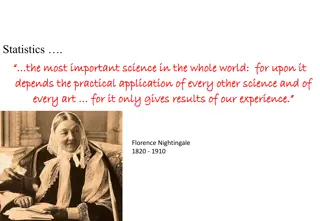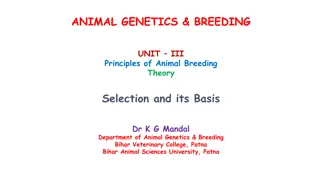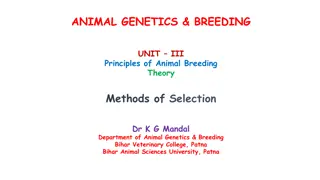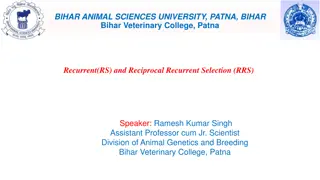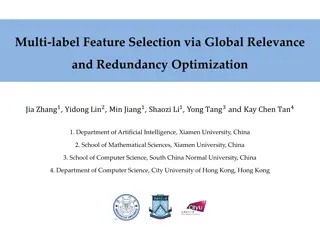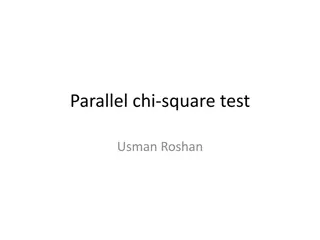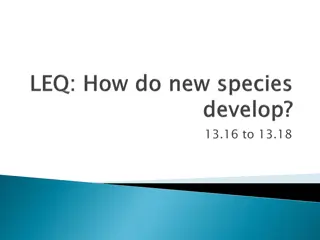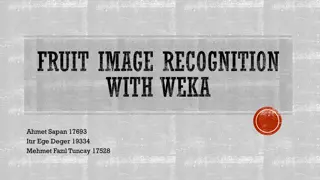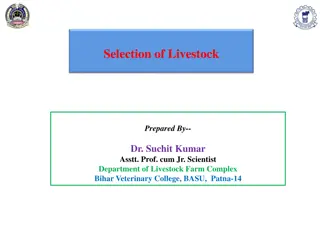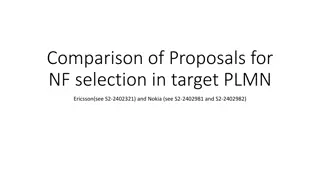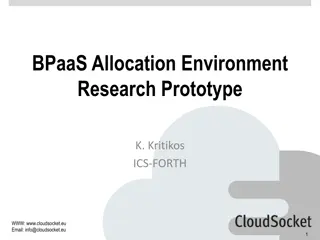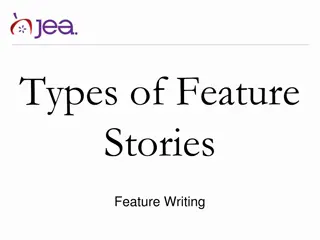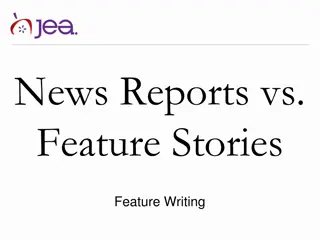
Introduction to Feature Selection
Explore the concept of feature selection through slides from UC Berkeley's CS294-10 course. Learn about filtering, model evaluation, regularization, and more in the context of data analysis and predictive modeling. Understand the importance of choosing the right features for optimal model performance and interpretation.
Download Presentation

Please find below an Image/Link to download the presentation.
The content on the website is provided AS IS for your information and personal use only. It may not be sold, licensed, or shared on other websites without obtaining consent from the author. If you encounter any issues during the download, it is possible that the publisher has removed the file from their server.
You are allowed to download the files provided on this website for personal or commercial use, subject to the condition that they are used lawfully. All files are the property of their respective owners.
The content on the website is provided AS IS for your information and personal use only. It may not be sold, licensed, or shared on other websites without obtaining consent from the author.
E N D
Presentation Transcript
Feature Selection [slides prises du cours cs294-10 UC Berkeley (2006 / 2009)] http://www.cs.berkeley.edu/~jordan/courses/294-fall09
Outline Review/introduction What is feature selection? Why do it? Filtering Model selection Model evaluation Model search Regularization Summary recommendations
Review Data: pairs : vector of features Features can be real ( ), categorical ( ), or more structured y: response (dependent) variable : binary classification : regression Typically, this is what we want to be able to predict, having observed some new .
Featurization Data is often not originally in vector form Have to choose how to featurize Features often encode expert knowledge of the domain Can have a huge effect on performance Example: documents Bag of words featurization: throw out order, keep count of how many times each word appears. Surprisingly effective for many tasks Sequence featurization: one feature for first letter in the document, one for second letter, etc. Poor feature set for most purposes similar documents are not close to one another in this representation.
What is feature selection? Reducing the feature space by throwing out some of the features (covariates) Also called variable selection Motivating idea: try to find a simple, parsimonious model Occam s razor: simplest explanation that accounts for the data is best
What is feature selection? Task: classify whether a document is about cats Task: predict chances of lung disease Data: medical history survey Data: word counts in the document X X cat and it kitten electric trouble then several feline while 2 35 20 8 2 4 5 9 2 4 Vegetarian Plays video games Family history Athletic Smoker Sex Lung capacity Hair color Car No Yes Reduced X Reduced X No No Yes Male 5.8L Red Audi cat kitten feline 2 8 2 Family history Smoker No Yes Weight lemon 185 lbs 2
Why do it? Case 1: We re interested in features we want to know which are relevant. If we fit a model, it should be interpretable. Case 2: We re interested in prediction; features are not interesting in themselves, we just want to build a good classifier (or other kind of predictor).
Why do it? Case 1. We want to know which features are relevant; we don t necessarily want to do prediction. What causes lung cancer? Features are aspects of a patient s medical history Binary response variable: did the patient develop lung cancer? Which features best predict whether lung cancer will develop? Might want to legislate against these features. What causes a program to crash? [Alice Zheng 03, 04, 05] Features are aspects of a single program execution Which branches were taken? What values did functions return? Binary response variable: did the program crash? Features that predict crashes well are probably bugs. What stabilizes protein structure? (my research) Features are structural aspects of a protein Real-valued response variable protein energy Features that give rise to low energy are stabilizing.
Why do it? Case 2. We want to build a good predictor. Text classification Features for all 105 English words, and maybe all word pairs Common practice: throw in every feature you can think of, let feature selection get rid of useless ones Training too expensive with all features The presence of irrelevant features hurts generalization. Classification of leukemia tumors from microarray gene expression data [Xing, Jordan, Karp 01] 72 patients (data points) 7130 features (expression levels of different genes) Disease diagnosis Features are outcomes of expensive medical tests Which tests should we perform on patient? Embedded systems with limited resources Classifier must be compact Voice recognition on a cell phone Branch prediction in a CPU (4K code limit)
Get at Case 1 through Case 2 Even if we just want to identify features, it can be useful to pretend we want to do prediction. Relevant features are (typically) exactly those that most aid prediction. But not always. Highly correlated features may be redundant but both interesting as causes . e.g. smoking in the morning, smoking at night
Outline Review/introduction What is feature selection? Why do it? Filtering Model selection Model evaluation Model search Regularization Kernel methods Miscellaneous topics Summary
Filtering Simple techniques for weeding out irrelevant features without fitting model
Filtering Basic idea: assign score to each feature indicating how related and are. Intuition: if for all i, then is good no matter what our model is contains all information about . Many popular scores [see Yang and Pederson 97] Classification with categorical data: Chi-squared, information gain Can use binning to make continuous data categorical Regression: correlation, mutual information Markov blanket [Koller and Sahami, 96] Then somehow pick how many of the highest scoring features to keep (nested models)
Comparison of filtering methods for text categorization [Yang and Pederson 97]
Filtering Advantages: Very fast Simple to apply Disadvantages: Doesn t take into account which learning algorithm will be used. Doesn t take into account correlations between features This can be an advantage if we re only interested in ranking the relevance of features, rather than performing prediction. Also a significant disadvantage see homework Suggestion: use light filtering as an efficient initial step if there are many obviously irrelevant features Caveat here too apparently useless features can be useful when grouped with others
Outline Review/introduction What is feature selection? Why do it? Filtering Model selection Model evaluation Model search Regularization Summary
Model Selection Choosing between possible models of varying complexity In our case, a model means a set of features Running example: linear regression model
Linear Regression Model Model Data Parameters Prediction rule: Response: Assume is augmented to so the constant term is absorbed into as and Recall that we can fit it by minimizing the squared error: Can be interpreted as maximum likelihood with
Least Squares Fitting Error or residual Observation Prediction 0 0 20 Sum squared error:
Model Selection Data Model Parameters Prediction rule: Response: Consider a reduced model with only those features for Squared error is now We want to pick out the best . Maybe this means the one with the lowest training error ? Note Just zero out terms in to match . Generally speaking, training error will only go up in a simpler model. So why should we use one?
Overfitting example 1 30 25 20 Degree 15 polynomial 15 10 5 0 -5 -10 -15 0 2 4 6 8 10 12 14 16 20 18 This model is too rich for the data Fits training data well, but doesn t generalize.
Overfitting example 2 Generate 2000 , i.i.d. Generate 2000 , i.i.d. completely independent of the s We shouldn t be able to predict at all from Find Use this to predict for each by It really looks like we ve found a relationship between and ! But no such relationship exists, so will do no better than random on new data.
Model evaluation Moral 1: In the presence of many irrelevant features, we might just fit noise. Moral 2: Training error can lead us astray. To evaluate a feature set , we need a better scoring function We ve seen that is not appropriate. We re not ultimately interested in training error; we re interested in test error (error on new data). We can estimate test error by pretending we haven t seen some of our data. Keep some data aside as a validation set. If we don t use it in training, then it s a fair test of our model.
K-fold cross validation A technique for estimating test error Uses all of the data to validate Divide data into K groups . Use each group as a validation set, then average all validation errors X7 X1 X6 Learn X2 X5 X3 X4
K-fold cross validation A technique for estimating test error Uses all of the data to validate Divide data into K groups . Use each group as a validation set, then average all validation errors X7 X1 X6 Learn X2 X5 X3 X4
K-fold cross validation A technique for estimating test error Uses all of the data to validate Divide data into K groups . Use each group as a validation set, then average all validation errors X7 X1 X6 Learn X2 X5 X3 X4
K-fold cross validation A technique for estimating test error Uses all of the data to validate Divide data into K groups . Use each group as a validation set, then average all validation errors X7 X1 X6 Learn X2 X5 X3 X4
Model Search We have an objective function Time to search for a good model. This is known as a wrapper method Learning algorithm is a black box Just use it to compute objective function, then do search Exhaustive search expensive 2n possible subsets s Greedy search is common and effective
Model search Forward selection Backward elimination Initialize s={} Do: Add feature to s which improves K(s) most While K(s) can be improved Initialize s={1,2, ,n} Do: remove feature from s which improves K(s) most While K(s) can be improved Backward elimination tends to find better models Better at finding models with interacting features But it is frequently too expensive to fit the large models at the beginning of search Both can be too greedy.
Model search More sophisticated search strategies exist Best-first search Stochastic search See Wrappers for Feature Subset Selection , Kohavi and John 1997 For many models, search moves can be evaluated quickly without refitting E.g. linear regression model: add feature that has most covariance with current residuals RapidMiner can do feature selection with cross- validation and either forward selection or backwards elimination. Other objective functions exist which add a model- complexity penalty to the training error AIC: add penalty to log-likelihood. BIC: add penalty
Outline Review/introduction What is feature selection? Why do it? Filtering Model selection Model evaluation Model search Regularization Summary
Regularization In certain cases, we can move model selection into the induction algorithm Only have to fit one model; more efficient. This is sometimes called an embedded feature selection algorithm
Regularization Regularization: add model complexity penalty to training error. for some constant C Now Regularization forces weights to be small, but does it force weights to be exactly zero? is equivalent to removing feature f from the model
L1 vs L2 regularization To minimize , we can solve by (e.g.) gradient descent. Minimization is a tug-of-war between the two terms
L1 vs L2 regularization To minimize , we can solve by (e.g.) gradient descent. Minimization is a tug-of-war between the two terms
L1 vs L2 regularization To minimize , we can solve by (e.g.) gradient descent. Minimization is a tug-of-war between the two terms
L1 vs L2 regularization To minimize , we can solve by (e.g.) gradient descent. Minimization is a tug-of-war between the two terms w is forced into the corners many components 0 Solution is sparse
L1 vs L2 regularization To minimize , we can solve by (e.g.) gradient descent. Minimization is a tug-of-war between the two terms
L1 vs L2 regularization To minimize , we can solve by (e.g.) gradient descent. Minimization is a tug-of-war between the two terms L2 regularization does not promote sparsity Even without sparsity, regularization promotes generalization limits expressiveness of model
Lasso Regression [Tibshirani 94] Simply linear regression with an L1 penalty for sparsity. Two big questions: 1. How do we perform this minimization? With L2penalty it s easy saw this in a previous lecture With L1it s not a least-squares problem any more 2. How do we choose C?
Least-Angle Regression Up until a few years ago this was not trivial Fitting model: optimization problem, harder than least-squares Cross validation to choose C: must fit model for every candidate C value Not with LARS! (Least Angle Regression, Hastie et al, 2004) Find trajectory of w for all possible C values simultaneously, as efficiently as least-squares Can choose exactly how many features are wanted sklearn.linear_model.Lars Figure taken from Hastie et al (2004)
Outline Review/introduction What is feature selection? Why do it? Filtering Model selection Model evaluation Model search Regularization Summary
Summary Filtering L1 regularization (embedded methods) Kernel methods Wrappers Forward selection Backward selection Other search Exhaustive Computational cost
Summary Filtering L1 regularization (embedded methods) Kernel methods Wrappers Forward selection Backward selection Other search Exhaustive Good preprocessing step Information-based scores seem most effective Information gain More expensive: Markov Blanket [Koller & Sahami, 97] Fail to capture relationship between features Computational cost
Summary Fairly efficient LARS-type algorithms now exist for many linear models Ideally, use cross- validation to determine regularization coeff. Not applicable for all models Linear methods can be limited Common: fit a linear model initially to select features, then fit a nonlinear model with new feature set Filtering L1 regularization (embedded methods) Kernel methods Wrappers Forward selection Backward selection Other search Exhaustive Computational cost
Summary Expand the expressiveness of linear models Very effective in practice Useful when a similarity kernel is natural to define Not as interpretable They don t really perform feature selection as such Achieve parsimony through a different route Sparsity in data Filtering L1 regularization (embedded methods) Kernel methods Wrappers Forward selection Backward selection Other search Exhaustive Computational cost
Summary Filtering L1 regularization (embedded methods) Kernel methods Wrappers Forward selection Backward selection Other search Exhaustive Most directly optimize prediction performance Can be very expensive, even with greedy search methods Cross-validation is a good objective function to start with Computational cost
Summary Filtering L1 regularization (embedded methods) Kernel methods Wrappers Forward selection Backward selection Other search Exhaustive Too greedy ignore relationships between features Easy baseline Can be generalized in many interesting ways Stagewise forward selection Forward-backward search Boosting Computational cost
Summary Generally more effective than greedy L1 regularization (embedded methods) Kernel methods Wrappers Forward selection Backward selection Other search Exhaustive Filtering Computational cost

